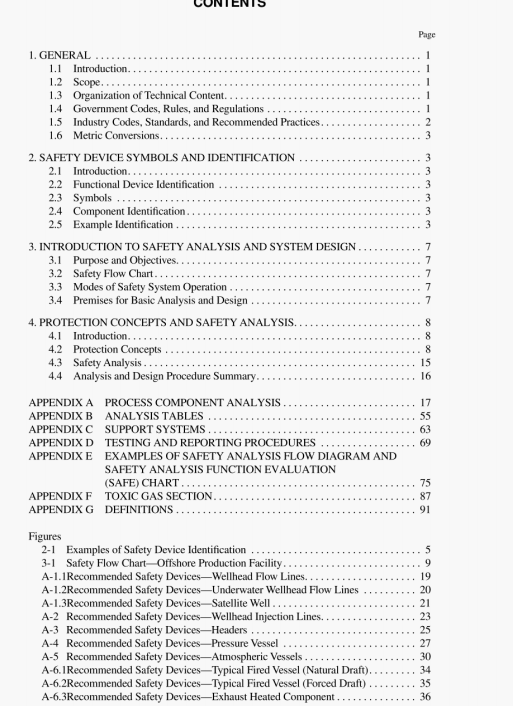API RP 14C:2001 pdf download.Recommended Practice for Analysis,Design, Installation, and Testing of Basic Surface Safety Systems for Offshore Production Platforms.
4.2.4.2 ElectrIcal Codes and Recommended Practices
Protection from ignition by electrical sources should be provided by designing and maintaining electrical equipment in accordance with API Recommended Practice I4F or other applicable standards, and by classification of platform areas according to API Recommended Practice 500.
a. API Recommended Practice 14F defines criteria for electrical equipment and wiring methods that can he used safely in classified and unclassified areas on offshore production platforms.
h. API Recommended Practice 5(k) presents methods for classifying areas surrounding drilling rigs and production facilities on land and on marine fixed and mobile platforms for safe installation of electrical equipment.
4.2.4.3 Location
Potential ignition sources, such as fired process componcnts and certain rotating machinery, arc normally equipped to minimite the possibility of igniting released hyd carbons. Additional prouxtion can be provided by locating equipment in areas where exposure to inadvertently released hydrocarbon,. is minimited. API Recomiriended Practice 14J provides guidance 11w locating equipment. Some other poential ignition sources are those related to housekeeping such as boilers. water beaters, stoves. clothes dryers. etc. These should be located in electrically unclassified areas. If such equipment is gas fueled and installed in an inadequately ventilated building, a combustible gas detector (ASH) should he installed to close fuel shutdown valves located outside the building.
4.2.4.4 Hot Surface Protection
Any surface with a temperature in excess of 4 F (2(WC) should he protected from exposure to hydrocarbon liquids due to spillage or leakage. Surfaces with a temperature in excess of 725F (3X5C) (approximately 8() percent of the ignition temperature of natural gas) should be protected from exposure to accumulations of combustible gases and vapors. Methods of protcctum can be insulation, barriers, water cooling, etc. However, if such surfaces on permanent or portable equipment arc in an area classified by API Recommended Practice 500, they should be insulated. Some mechanical components such as turhochargers. exhaust mnanilllds and the like (including associated piping) that cannot be insulated without causing mechanical failure should be protected by other means.
4.2.6 Emergency Support Systems (ESS)
The Emergency Support Systems (discussed in detail in Appendix C) minimize the elkcis of escaped hydrocarbons on offshore production platforms. The ESS includes:
a. The combustible gas detection system to sense the presence of escaped hydrocarbons and initiate alarms and platlimi shutdown before gas concentrations reach the LEL b. The containment system to collect escaped liquid hydrocarbons and initiate platform shutdown.
c. The fire loop system to sense the beat of a lire and initiate platform shutdown.
d. Other fire detection devices (flame. thermal, and smoke) that are used to enhance fire detection capability.
e. The Emergency Shutdown System to provide a method to manually initiate platform shutdown by personnel observing abnormal conditions or undesirable events.
f. The SSSVS that may be self actuated (SSCSV) or activated by an F.S[) system and/or a fire loop (SCSSV).
API RP 14C:2001 pdf download
